Growing Food in Containers
Get a bumper crop from your patio by container gardening with vegetables.
Container gardeners have experienced a renewed interest in vegetables, and for good reason. Growing your own food offers more than the prospect of a belly full of healthy veggies; it also comes with a sense of pride and accomplishment. After all, it takes a good plan, committed effort, and a certain amount of acquired skill to grow backyard produce from seed or seedling to maturity. If you’ve been longing to get some dirt under your nails but in-ground gardening isn’t for you, it’s time to consider container gardening.
Container vegetable gardening is a great way to grow food in less space, with less bending and stooping, and with fewer pest problems than traditional gardening methods. The only items you need to get started include planting containers, soil, starter plants and/or seeds, and a few small hand tools such as a watering can, trowel, and scissors or a sharp knife.
7 rules of container vegetable gardening
It’s not difficult to produce loads of food on your deck, balcony, or patio, if you follow these basic container gardening principles.
Choose the sunniest possible location.
Most vegetables need at least 4 to 6 hours of direct sunlight to grow and fruit properly. Less than ideal light leads to slow, weak growth, and increased pest problems. If your patio gets lots of sun, great! If not, consider the driveway, front stoop, or other, sunnier spots.
Plant selection
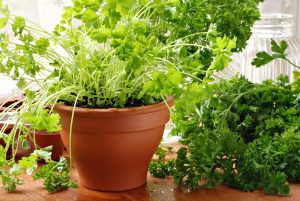
Use extra large containers.
Container selection can make or break your project. Go with container sizes of about three gallons and up. Larger pots hold more soil, more plants, and more moisture to keep plants hydrated through hot summer days. The best containers for vegetable gardening are made of materials like plastic, glazed pottery, or wood, that reduce moisture loss. Stay away from unglazed terra cotta.
Don’t skimp on the soil.
High quality outdoor container gardening soil provides three essential elements. It is made with a blend of organic materials with different particle sizes that resist compaction. It includes some large organic particles and perlite that retain moisture for an extended time, reducing dry-out. And, it provides some starter plant food. Cheap potting soil is likely to dry out quickly and become compacted.
Supplement with fertilizer.
Although bagged potting soils contain some plant food, it may not be enough for a full growing season. Especially for heavy feeding crops like broccoli, cucumbers, peppers, and tomatoes. Consider supplementing with granular organic or slow release fertilizer at planting time. Then follow up with targeted applications of liquid plant food when the garden needs an extra nutrient boost, like when tomatoes are setting fruit or while onions are developing new foliage.
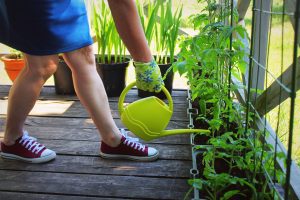
Keep your garden hydrated.
Vegetable plants grow best with consistently moist soil. Ideally the soil should maintain the wetness of a lightly wrung out sponge. If it stays soggy or too dry, or fluctuates widely between the two, the plants get stressed. Daily watering at the peak of the summer is normal. Water in the early morning to keep plants from wilting during the day, then supplement in the evenings if necessary.
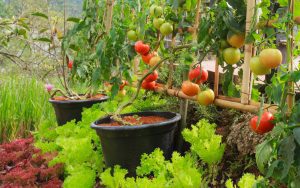
Use plant supports to save space.
Vertical growing techniques help to keep small garden spaces organized while protecting plants and fruits from damage. Support top-heavy tomatoes and peppers with garden stakes. Vining plants such as pole beans and cucumbers can be outfitted with pot-sized trellises to keep the runners growing in the right direction. Tomato cages work well to keep squash plants off the ground.
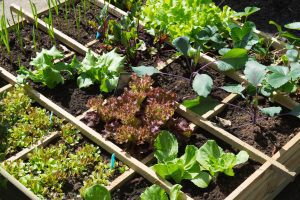
8 best vegetables for container gardening
Virtually any plant can be grown in a pot, but some are better adapted than others. Some things to consider prior to choosing crops for containers include the overall size of the plant, the time it takes to grow and produce edible veggies, whether it produces a single harvest (like a carrot) or multiple fruits (like cucumbers), whether it grows well around or combined with other plants. All of this information can be found on individual seed packets or plant labels. Some of the most popular and most successful container gardening vegetable crops are as follows.
Tomatoes are the most popular garden vegetable, and they happen to be perfectly at home in containers. Use plant stakes to support them as they grow.
Broccoli produces a main head followed by secondary florets after the main head is harvested. ‘Di Cicco’ is a variety known for heavy production of secondary florets.
Potatoes produce abundantly in deep containers. Fill the pot one-third of the way with soil, plant the seed potato and cover it with an inch of soil. When the plant is 8 to 12 inches tall add soil so that only the top leaves are exposed. Repeat until the container is full of soil.
Onions are part of nearly every great recipe. For proper spacing, calculate the area of the soil surface, and plant 9 per square foot (144 square inches).
Carrots and other root veggies need deeper pots than other veggies.
Beans and peas produce abundant crops within the confines of a container. Use a tall trellis to keep them upright.
Leafy greens for salads or cooking such as spinach, lettuce, kale, or mustard thrive in containers.
Cucumbers give a bountiful harvest but need support to stay in bounds. Use a narrow trellis or tall tomato cage.
To maximize space, interplant vegetables that grow well together in containers. Some traditionally successful container garden combinations include
- Spinach, chard, and onions
- Tomato, basil, and carrots
- Cucumber and lettuce
- Beans and squash
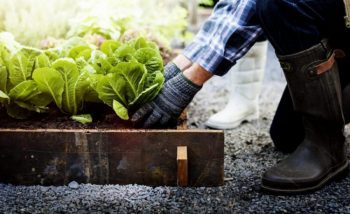

You must be logged in to post a comment.